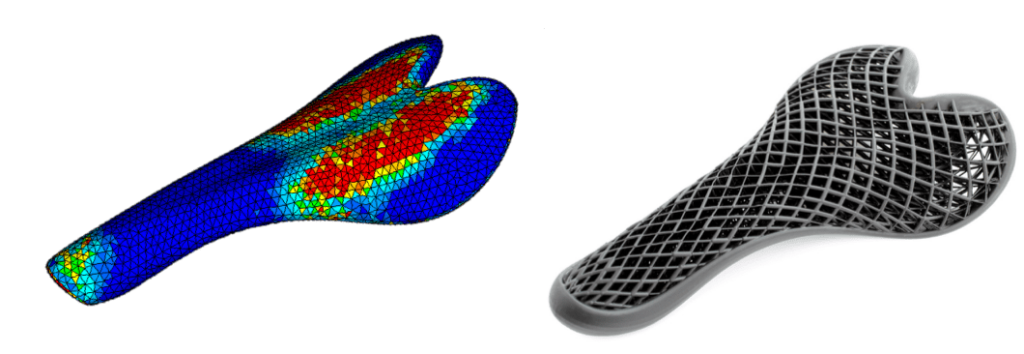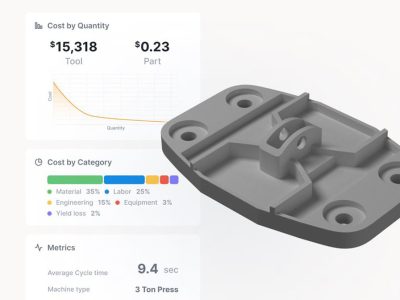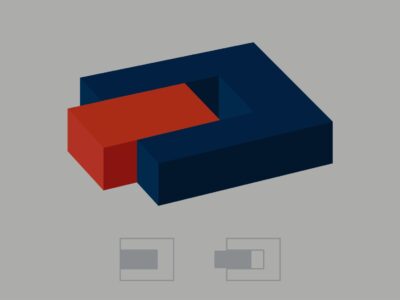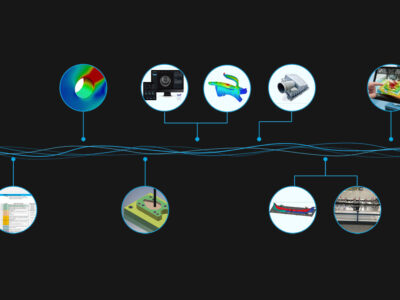Originally published on fastradius.com on November 11, 2020
Topology optimization (TO or TopOp) is a mathematical method that optimizes material layout within a given space, taking into account given load or boundary restrictions. Topology optimization allows designers to optimize a mechanical component or part, typically through material reduction.
Topology optimization is a form of generative design, which refers to the combination of three different disciplines — design, simulation, and optimization — to create a simulation that considers thousands of millions of degrees of freedom to create an optimal solution.
Topology optimization enables designers to achieve a careful balance between strength and affordability, determining how to create a part that’s sufficiently strong using the least material possible. It does so in a way that would be incredibly difficult to achieve without the help of a computer. This can sometimes result in some odd shapes, which is why topology optimization goes hand-in-hand with additive manufacturing; 3D printing is the most effective tool for manufacturing these complex parts.
Topology optimization software ultimately enables designers to take advantage of the freedom offered by additive manufacturing. However, until recently, it was prohibitively expensive for many product teams. It’s only in the past few years that topology optimization has become a built-in feature in many popular CAD programs, making it far more accessible. Here’s what product teams need to know about this powerful tool.
How topology optimization works
The most popular and practical topology optimization methods are finite element (FE)-based. FE refers to a design method that relies on simulations to determine which areas of an object aren’t structurally critical and can therefore be potentially removed.
The first step to FE-based topology optimization is defining the loads, fixtures, constraints, and “design space,” or the maximum volume that a given part can potentially occupy. The software will then analyze the specific restraints to offer several part design options and guide the designer in the direction of the best-possible design. When a design is selected, the software will repeat the process to refine the geometry
Generally, parts designed using topology optimization use less material to achieve the same or better results, translating to direct cost savings and an improved product. Because topology optimization can cut excess weight from many designs, the technology is especially popular for metal components in the aerospace and automotive industries, both of which benefit from increased fuel efficiency when the volume or weight of part materials are reduced. What’s more, because topology optimization and additive manufacturing enable designers to closely mimic organic shapes, the technology is being increasingly leveraged for medical applications.

Benefits of topology optimization
The advantages of topology optimization extend beyond material reduction. Some of its other benefits include:
- A shortened design process: Topology optimization can drastically reduce product development timelines — which translates to reduced costs. The automated process generally leads to better-performing parts in much less time than would be needed for traditional design methods.
- Better performance: The best design for a given part isn’t always intuitive, and it’s possible that a design team would have never come up with it without the help of a computer. Topology optimization algorithms don’t have the biases that humans do, so they tend to disregard aesthetics and common design rules in favor of improved performance.
Greater energy- and cost-efficiency. Topology optimization eliminates any unnecessary features or material, reducing both waste and cost. What’s more, because these parts are lighter, they also tend to reduce energy demand in their end-use applications.
Popular topology optimization software
Topology optimization software can be purchased as a standalone tool or a CAD-integrated module. Two major players in topology optimization are Altair and Dassault Systèmes. Altair first released the OptiStruct tool in 1994, and General Motors was its first customer. Dassault Systèmes is responsible for several popular TopOp modules, including Tosca and ATOM.
A handful of popular CAD programs, including Solidworks and Creo, come with built-in topology optimization tools. Note that these tools tend to be less powerful and feature-heavy than standalone TO software. That said, they are capable of providing valuable insights during the design process.
nTop Platform is a new type of CAD software whose integrated TopOp modules allow the data output of simulations to directly drive design parameters such as variable wall thickness or lattice beam thickness, bringing new functionalities to the software landscape.

Getting started with topology optimization
Both modern businesses and consumers demand solutions that are faster, more efficient, more effective, and more environmentally-friendly than ever before. Topology optimization can deliver these benefits and more to product teams. Luckily, the technology is becoming more widely accessible, too. However, making the most of TO software and optimizing the product development process requires that teams have a deep functional knowledge of how to use the technology effectively.
Product teams of all shapes and sizes who are interested in leveraging topology optimization to create better-performing, less expensive parts at speed can consult the experts at SyBridge. Our team of seasoned designers, engineers, technologists, and project managers are experts in digital design, simulation, and performance optimization. Our mission is to help our customers make new things possible. Contact us to get started.






